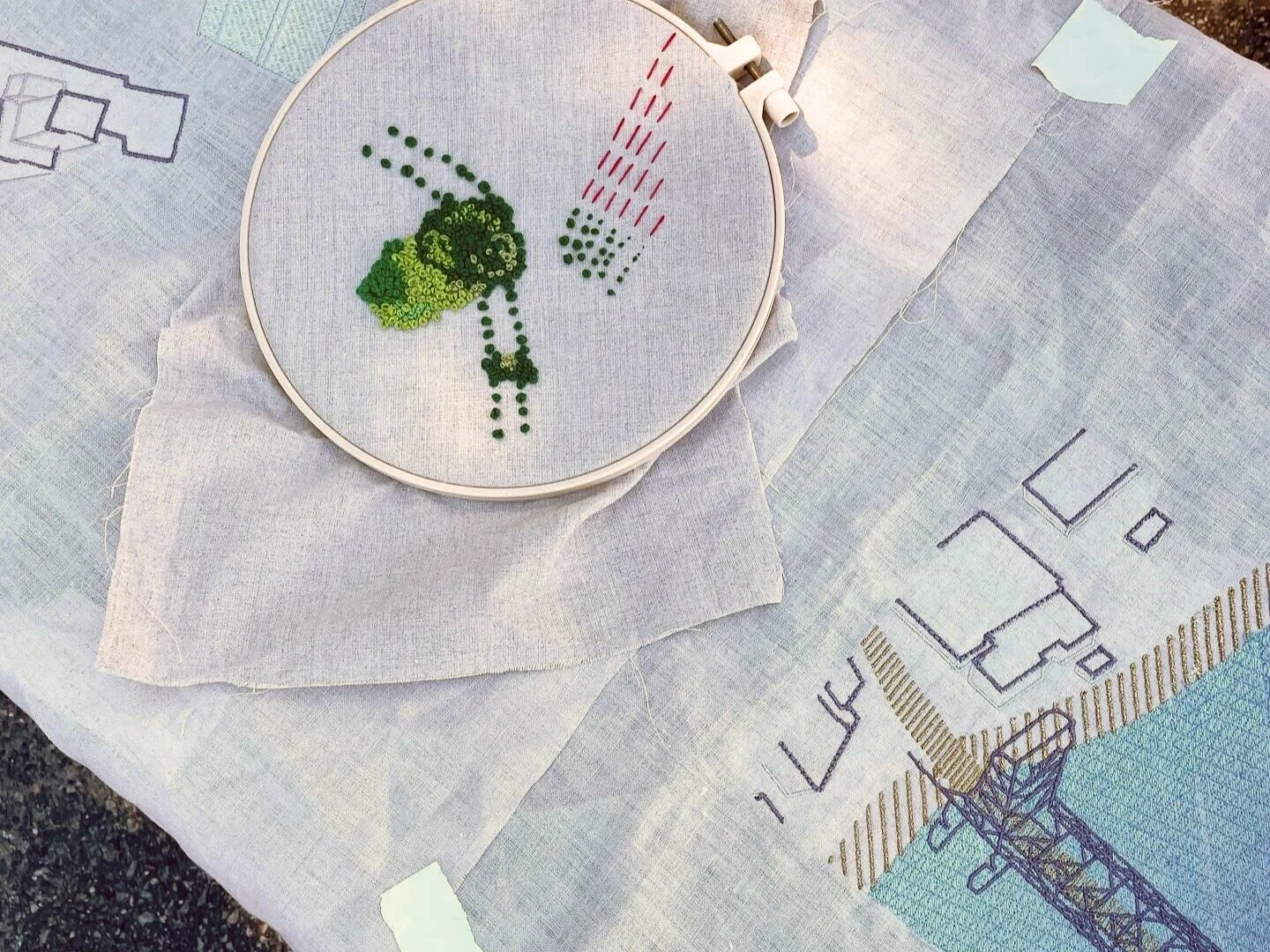The Tibbetts Estuary Tapestry
A Community Embroidery Artist Project
with artists Ana de la Cueva and Matthew Lopez-Jensen
The Tibbetts Estuary Tapestry Project imagines green roofs on all of the buildings along Broadway that were built on former wetlands.
CALL//CITY AS LIVING LABORATORY presents Tibbetts Estuary Tapestry by artists Ana de la Cueva and Matthew López-Jensen at the Van Cortlandt House Museum (in Van Cortlandt Park at Broadway and West 246th Street). Following its opening on December 10, 2022 it will remain on view through March 2023. To create the quilt the artists devised an intricate process, offering in-person and on-line workshops and tutorials to over 100 volunteers – inviting them to embroider their visions of a greener, future Broadway corridor onto 10”x10” fabric squares. The 15’ long quilt is displayed within the centuries-old context of the 18th century farmhouse - the oldest building in the Bronx. Accompanied by other historical quilts, the installation creates a dialogue between the borough’s past, present, and future.
Matthew López-Jensen is a Bronx-based interdisciplinary artist whose practice combines photography, video, walking, and mapping to explore the many social, historical, and ecological layers of landscapes. He currently teaches fine arts and photography at Parsons School of Design and Fordham University. Ana de la Cueva’s work encompasses embroidery, ceramics, photography, video, printmaking, painting, and sculpture. She employs these media to question issues regarding territories, history, gender, identity, and tradition. She is based in New York City and Guadalajara.
Over the course of two years de la Cueva and López-Jensen held numerous in-person and online workshops to teach volunteers how to do the specific stitches they had chosen to represent the plants which are most adaptable to green roofs and urban streetscapes. They created 15 instructional videos on how to stitch representations of resilient plants, such as Purple Love Grass, Hens and Chickens, Eastern Prickly Pear, and many more. All participants were invited to create their own imaginary garden; many of them took the artists’ recommendations to heart and went far beyond the representation of sanctioned plants; a reason why the quilt is so delightful. The completed squares were returned to CALL and then forwarded to Ana de la Cueva at her studio in Guadalajara, Mexico, where she oversaw their assembly and embellishment into the finished piece.
The concept for the crowd-sourced quilt was motivated by the vast, impermeable hardscape of big box stores, snarled roadways, and concrete parking lots that flank Broadway from the Harlem River to Van Cortlandt Park. These buildings and roadways exacerbate flooding along this iconic thoroughfare built on land that was once a rich tidal estuary at the confluence of Tibbetts Brook and Spuyten Duyvil Creek.
Today, the hard surfaces of Broadway’s corridor exacerbate persistent flooding, especially with the advent of climate change which is causing more severe storms. The artists ask: what if there was a coordinated effort to create a mile-long collection of continuous green roofs, transforming this flat, gray expanse into an array of living habitats? It would cool the neighborhood, clean the air, provide habitat for plants, insects, and birds, mitigate flooding events for generations. Beyond this, it would be beautiful.
The communal process of producing Tibbetts Estuary Tapestry was intended to ignite peoples’ imaginations and point to real opportunities for modest interventions that could collectively change the urban landscape in significant ways and make it more sustainable through greening and storm-water capture. The Tapestry reflects CALL’s mission to make sustainability tangible through the arts.
CALL was founded by artist Mary Miss in 2011 to address the daunting environmental problems now facing our rapidly changing planet. Since 2017, CALL has been working in the Bronx on Rescuing Tibbetts, an effort to build advocacy and public engagement around daylighting (bringing to the surface) Tibbetts Brook, whereby the buried stream will be uncovered to create a new linear park along an abandoned CSX railbed.
The presentation of the quilt was made possible with the collaboration of the Van Cortlandt House Museum and its Director, Nick Dembowski. Dembowski sees this exhibition as an opportunity to present a vision of the borough’s future in conversation with its past. The Tapestry also resonates with the Museum’s 1913 needlework exhibition which was presented at the height of the American suffrage movement; the exhibition included embroideries dating from 1625 to 1800. The 1913 show sought to elevate domestic crafts and women’s work in a groundbreaking exhibition visited by thousands. During the planning of the Tibbetts Estuary Tapestry exhibition, it came to light that two collaborative quilts made by Bronx residents existed in the Museum’s archives; they were produced in the 1970s as part of the borough’s bicentennial celebrations. These pieces are currently on display alongside the Tibbetts Estuary Tapestry, expanding on the history of community textile art in the borough.
Furthermore, the museum’s location in Van Cortlandt Park abuts the site where Tibbetts Brook disappears underground at the south end of Hester and Piero’s Mill Pond (formerly Van Cortlandt Lake) into the Broadway sewer.
Tibbets Estuary Tapestry is generously supported by the COBY Foundation, the National Endowment for the Arts, New York State Council on the Arts, the Mellon Foundation, the New York City Department of Cultural Affairs, and individual contributors.
Learn more about Tibbetts Brook and Green Roofs!
Here’s an interactive map, a collection of videos, and other resources to help you learn more about the environmental science behind this project and the history of Tibbetts Brook in the Bronx.







